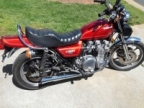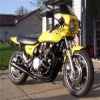- Posts: 323
- Thank you received: 0
Rattlecan repaint
- ronboskz650sr
- Offline
- User
Please Log in or Create an account to join the conversation.
- ltdrider
-

- Offline
- User
- Posts: 1232
- Thank you received: 17
Looks professional. Great color, too. I'll keep the DupliColor in mind for my next (don't hold your breath) project.
'76 KZ900 LTD (Blaze)
'96 Voyager XII (Dark Star)
'79 KZ650 Cafe Project (Dirty Kurt)
Greensboro, NC
Please Log in or Create an account to join the conversation.
- John68
- Offline
- User
- Posts: 114
- Thank you received: 0
How can you argue with someone like that, I mean, just look at his picture, he looks like he means business.
...don't wanna be a thread hijacker, though. so, nice paint color, looks pretty, and green. I'm sure it looks better than what it did before. That's the most important thing. Now, if it looked better before you painted it... heh heh heh... j/k
good job.
Please Log in or Create an account to join the conversation.
- ronboskz650sr
- Offline
- User
- Posts: 323
- Thank you received: 0
Please Log in or Create an account to join the conversation.
- John68
- Offline
- User
- Posts: 114
- Thank you received: 0
Thats cool. I think you'd be happier with the single stage's appearance, vs. 2 stage paint. I know I can tell the difference between the 2 finishes! Let us all know how that turns out.
Please Log in or Create an account to join the conversation.
- ronboskz650sr
- Offline
- User
- Posts: 323
- Thank you received: 0
Please Log in or Create an account to join the conversation.
- BARNEYHYPHEN
- Topic Author
- Offline
- User
- Posts: 419
- Thank you received: 1
Please Log in or Create an account to join the conversation.
- Shoey949
- Offline
- User
- Posts: 104
- Thank you received: 1
'83 GPz550H2 w/'81 GPz 550D1 engine
Dynojet Stage 3 kit, MAC 4-1, UNI Pods, DYNA coils and plug wires, WG ignition mod
Grand Rapids, MI
Please Log in or Create an account to join the conversation.
- indykaw77
-

- Offline
- User
- Posts: 510
- Thank you received: 4
Kawasaki Motorcycles...because cars lean th wrong way!
Please Log in or Create an account to join the conversation.
- John68
- Offline
- User
- Posts: 114
- Thank you received: 0
Shoey,
if you are gonna clearcoat your work, with duplicolor clear, get some spray-out cards to lay on the color coats. If you are not sure where to get spray-out cards, email me, and I can mail you some. All they are, is a piece of card stock, with a hole in the middle, half of the card is black, and half of the card is white, with the two colors meeting at the hole in the middle. When you spray a coat of color onto the piece, you spray a coat of color onto the card. Then, when the line between the white and the black is not visable anymore, you have sufficient paint on the piece. This is a guide to show you when you have full coverage, so as not to waste paint, or apply it too thick, causing slow drying, cracking and other nasty side effects. The hole in teh middle allows you to lay it onto your work(when dry, of course) to see if the color of the piece matches the color of the paint on the spray out card. I know a lot of older bodymen, who used to say things like, "52 coats of hand rubbed laquer is the only way to paint, blah blah blaaahhh..." In reality, they are fools. True, the paint job looks like it was touched by the most brilliant hand ever created... then, after a year or so... crap. why? because back in "the day" painters painted everything with acrylic laquer (which hasn't been used by any of the automakers since 1978). Laquer is a non-catylist paint, which air dried hard, and shrank, also had very poor UV protection and therefore faded color, cracked, peeled, shrank, you name it...
Also, Laquer primer was nothing more than laquer paint, usually with no gloss additives and therefore, priming an object was merely painting it but with a cheap colorless paint, which could be sanded down, and was a lot cheaper than wasting actual pigmented paint on a vehicle. Now, as with color coats, laquer primer shrank also. The longer it was left to dry, the more it shrank. So, putting a showcar into a "primer" and leaving it that way for months was very common, so that the final paint didn't show as many inperfections. Even the scratch filler, or spot putty used back then was laquer paint, but made into a paste form. I'm sure you've heard of it, or seen it in stores. The most common brand is "Nitro-Stan." I still have a tube of it somewhere, for when I work on an old corvette, now and then. The system as a whole was not bad. you had regular plastic bodyfiller, spot filler(Nitro-Stan), laquer primer, and finally laquer paint. Laquer paint, being non-catylist, was sprayed with only the addition of a reducer, or "thinner." Laquer thinner is still around today, for use mainly as a clean-up solvent, more than anything. The basis for a laquer paint job was to thin out the laquer paint so that it could be sprayed out very evenly, without much orange-peel. Then, as the laquer thinner evaporated, this made the paint "hard" or dry. Due to the evaporative cooling process of laquer thinner, as with any evaporative liquid, condensation formed on the paintjob, as a result. This was especially true on a humid day. This made the paint job look hazy or cloudy, as opposed to shiney adn reflective. This is where the need for buffing came about. Laquer was so soft, even when fully dry, that a circular buffer with an abrasive compound could remove a lot of the orange peel and imperfections in the paint, with no need to wetsand. Laquer deffinitely had an advantage, here. Unfortunately, The shine wears off quickly, as well as the paint itself. Chemical strippers weren't even needed to remove a laquer paint job, since there was no chemical reaction to harden it on the workpiece. infact, some bodymen kept a primer gun, full of laquer primer and hardly ever cleaned out their primer guns. There wasn't a need to dump out the unused portion adn clean the gun. if the primer became too thick to spray, he would just add some more thinner, swirl it around and begin shooting. Laquer had another advantge.
Unfortunately, the benefits do not outweigh the drawbacks.
and I went off an a tangent... sorry... what I was getting to was, people who did those hand rubbed 52 coat paint jobs were actually using the final paint as a build primer and a body filler, and they were slowly sanding off the paint, as the applied more coats, so that the paint became 52 coats thick in some of the trouble areas. a decade or so later, even a pampered show car will show cracks and "crazing" as it is called, where the paint is too thick.
I am sure some of the guys on here who play with laquer primer and rattle cans will know what I am talking about, with shrinking problems. That's one of the things that will make you want to do it right. Sure, your paint job might look like you have been painting for years, and have the most skilled hand in the world, the day after you shoot it. Then, after a summer goes by, as you are waxing your pride and joy, you notice sanding scratches that weren't there before, and you notice that the wax isn't bringing the shine back, like it used to look. then, after a few years, you want to repaint it again, because it looks as weathered as it did before you started. Time is cruel to a paint job... sorry to say.
Anyhow, point is, lay it on thin, cover it with a good UV protectant clear coat, and don't do your bodywork with your primer and your paint. do the bodywork with hammers and dollies and plastic fillers. That's what they are there for. Some people say, "a good bodyman doesn't need 'bondo', he just isn't doing it right." wrong... a good bodyman knows when you use a hammer, when to use plastics and when things are ready for primer and paint. abuse of a product gives it a bad name, but 9 times out of 10, an inexperienced man will abuse the finish paint and primer, rather than use the reccomended amount of plastic fillers. Sad... but that's why I am offering advice to anyone wanting to know. It's not rocket science, in fact, a highschool tech student is learning how to work on your mercedes right now, and it will only take him 180 days, from 12pm to 3:30pm to learn well enough to be put in a working dealership. Scared? nah... don't be. Like I said, it's not rocket science.
I kinda rambled...
email me for sprayout cards
Please Log in or Create an account to join the conversation.
- Mcdroid
-

- Offline
- User
- Gone Kwackers
- Posts: 6637
- Thank you received: 322
When you are ready to do it with a gun and automotive paint, I'll be right here to walk you through it. It's actually easier than using a rattlecan, just requires more clean-up and learning how to mix.
Here's a not-so-hypothetical question...what do any of you think about the electric spray guns. Others may be considering a compressor + gun, but my breakerbox will absolutely not handle the amp load generated by a compressor. How are the electric guns w/o the compressor, e.g. I know they have them for house painting, will they work for auto painting?
Michael
Victoria, Texas
1982 GPz750
1977 KZ1000A
1978 KZ1000A
1982 GPz1100
1975 Z2A
Please Log in or Create an account to join the conversation.
- John68
- Offline
- User
- Posts: 114
- Thank you received: 0
Although, I am curious as to what size breaker your wall outlets are wired with. I am in the same boat as you are. I have a 20amp breaker for all the wall outlets on one side of the garage and I have a 120V 15amp compressor motor. LOL needless to say, I trip the breaker occasionally. Do you have 12 guage or greater wiring for your wall outlets? if so, you can safely have a 20amp breaker for the circuit. Changing a breaker is pretty simple. just pull it out, and snap the new one in. lick your fingers for good luck, as my uncle used to say. Of course, you know your wiring limitations better than I do. Most small compressors have 120V 15 amp motors, only a few I could find have less, but start up amperage is usually more than running amperage. www.harborfreight.com/cpi/ctaf/Displayitem.taf?itemnumber=36625 That one is an 11amp with enough scfm rating to power a conventional type spray gun. I used to use a similar one to paint whole cars. It was a drag, but it did the job. Since you will be painting motorcycle parts, you might be able to get away with a small 3 gallon compressor, as long as it has a SCFM rating above 2.8 @ 40. In fact... I just found this one...
www.harborfreight.com/cpi/ctaf/Displayitem.taf?itemnumber=47407
It seems to have adequate SCFM ratings for it's size. as far as the duty cycle goes, who knows. usualy you will only need it to sustain operating SCFM for a few minutes at a time, for each coat of paint. That particular unit appears to be rated for 2.5amps @120V. not too shabby for $70. I have a small 2 gallon one here, and am gonna be painting some things in the near future, so I will give it a shot, and depending on how it works, I will recomend or condemn. Figure, if it does work out, you will have $70 in the compressor, and $20 into the gun, for a complete spraying rig, that will last years.
hope this helps
EDIT: just found this... www.harborfreight.com/cpi/ctaf/Displayitem.taf?itemnumber=44677
if it works well, I'd be amazed. I'm no good at standard to metric conversions, but if anyone can convert the 0.70" tip size measurement into metric MM, and the mm size is above 1.8mm then I would say it wouldn't do a really spiffy job on your bike. 1.3-1.7 is ideal. 1.8-2.2 is for primer, and >2.2 is for resealing an asphalt driveway! :woohoo:
Post edited by: john68, at: 2005/10/22 11:04
Please Log in or Create an account to join the conversation.
